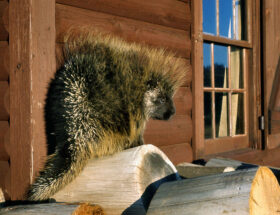Quick and Easy Navigation
WESTERN DIAMONDBACK RATTLESNAKE INTRODUCTION: SPECIES, PHYSICAL APPEARANCE
The western diamondback rattlesnake (crotalus atrox ) is one of about 29 rattlesnakes species in the Crotalus Genus – livescience.com. They are large-bodied venomous snakes and vary in color depending on the shade of their habitat. Their colorings range from brown, grayish to even pinkish. The scales form dark diamond-shaped patterns along its body with black and white bands in the tail just above the rattle. It has a triangular-shaped head with two dark stripes running from its eyes to the jaws.
Rattlesnakes are in the Viperidae family, making them pit vipers, just like the cottonmouth snake and the copperhead snake. This so-called loreal pit between its eyes and nostrils is an infrared detection organ. It allows them to sense the heat given off by prey or predators. Their eyes have elliptical-shaped pupils that are common in venomous snakes. But, not all snakes with elliptical pupils are venomous. Pythons for example have elliptical pupils and are not venomous. Another characteristic of venomous snakes is their two tubular fangs that are connected to the venom-producing glands.
WESTERN RATTLESNAKE HABITAT
The Western Diamondback rattlesnake can be found living in a wide variety of habitats. It lives in deserts, rocky hillsides, areas along the coast, grassy plains, and forests. They are comfortable in habitats from sea level to areas with elevations of 7,000 feet. In rural settings, trash piles and junkyards that provide refuge and attract rats and mice can also become a home for rattlesnakes.
WESTERN DIAMONDBACK SNAKE RANGE
Where do Western Diamondback rattlesnakes live? The western diamondback can be found throughout the southwestern United States and northern Mexico. Their range includes western Arkansas, eastern and south-central Oklahoma, Texas, central and southern New Mexico and Arizona, extreme southern Nevada, southern California, and southward into Mexico. The largest population of the western diamondback snake in the United State is found in Texas. Hence they are also known as the Texan rattlesnake.
In Mexico, the western diamondback rattlesnake is found in the state of Chihuahua, Coahuila, Durango (northeastern regions), Nuevo Leon, Oaxaca, Quéretaro, San Luis Potosi, Sonora, Tamaulipas, Veracruz, and Zacatecas.
WHAT DO DIAMONDBACK RATTLESNAKES EAT?
Western diamondback rattlesnake diet consists mainly of small animals such as mice, rats, rabbits, gophers, ground-dwelling birds, lizards, chipmunks, and squirrels. They strike their prey with a fatal bite and inject their venom. Rattlesnakes swallow their prey whole and digest their food as it travels through their body. On average, they eat every 2 to 3 weeks and barely drink any water.
Diamondback rattlesnakes are ambush predators. They hide and wait patiently for prey to come near. Their sense of smell and heat-sensing loreal pit helps them locate their victim and then they strike from a distance. According to the National Zoo Conservation and Biology Institute, the western diamondback rattlesnake can strike as far as two-thirds of their body length.
WESTERN DIAMONDBACK RATTLESNAKE VENOM
Are rattlesnakes poisonous? Yes, western diamondback rattlesnakes have large venom glands located in the frontal region of the upper jaw. A single bite contains an average of 250 mg to 350 mg of powerful venom. The maximum venom yield per bite is between 700-800 mg. The variation in the amount of venom delivered in a bite is controlled by muscles surrounding the glands that allow the snake to influence the flow.
The western diamondback rattlesnake’s venom is primarily hemotoxic. It contains a series of damaging proteins and enzymes that attack blood, blood vessels, the heart, and other tissue. The venom also produces a hemorrhagic effect. The venom is delivered through the fangs in a manner of seconds. The fangs sometimes break off and remain in the victim’s body but the snake is able to grow a new one in its place.
The primary purpose of the venom of the diamondback rattlesnake is to kill its prey and to aid digestion.
WESTERN DIAMONDBACK RATTLESNAKE BITE
The western diamondback rattlesnake will strike and bite when threatened, delivering the powerful venom and causing severe damage to the victim, and occasionally death to humans. A western diamondback rattlesnake bite is life-threatening and needs immediate medical attention.
The USDA Forest Service reports that about 8,000 people are bitten annually by venomous snakes in the United States, resulting in about 10-15 deaths. Most bites occur between the months of April and October when both snakes and humans are most active outdoors. About 25% of the bites are “dry bites”, meaning the snake just strikes for self-defense without delivering any poison to the victim. However, even a dry bite requires immediate medical attention. Most of the bites are triggered by humans accidentally stepping or touching the snake.
The western diamondback rattlesnake is one of the 10 deadliest snakes in North America. It is responsible for most snake-related deaths in Mexico and second to the eastern diamondback rattlesnake in the United States – Most Venomous Snakes in North America. The most venomous rattlesnake is arguably the eastern diamondback rattlesnake.
RATTLESNAKE SOUND
What does a rattlesnake sound like? Rattlesnakes make a distinctive noise that sounds like a rattle, hence their name. The noise is produced by the clacking of the hard rattles at the end of their tails when they shake their tails. Every time the rattlesnake sheds its skin, a new segment develops.
Rattlesnakes make the rattle sound as a warning, but it is important to note that they don’t always give a warning before they strike. Sometimes they shake their tails to warn potential predators to back off and sometimes they just strike without warning.
Aside from the rattle sound, rattlesnakes also hiss and buzz to ward off potential predators. All these sounds are a fair warning to anyone who comes too close. It is the rattlesnake’s way to signal they are scared and will proceed to more aggressive means of self-defense if a safe distance is not maintained.
WESTERN DIAMONDBACK RATTLESNAKE SIZE AND WEIGHT
On average the western diamondback rattlesnake is 4 feet long and weighs between 4- 6 pounds. The western diamondback rattlesnake is the largest rattlesnake in the west and the second largest in the United States. The largest rattlesnake is the eastern diamondback rattlesnake.
HOW BIG DO DIAMONDBACK RATTLESNAKES GET?
As reported by the University of Texas, Amphibian and Reptile Diversity Research Center, the largest reported measurement of a western diamondback rattlesnake is 92.5 inches. This measurement was recorded in 1997. A measurement of 92 inches was previously recorded in 1949. Although the average diamondback rattlesnake is about 4 feet long, snakes measuring more than 5 feet long are still found in southwestern Dallas county.
WESTERN DIAMONDBACK RATTLESNAKE ADAPTATIONS
Western diamondback snakes are a type of snake called pit vipers. A pit viper is any species of snake that has a heat-sensing organ between the eyes and nostrils. It is a hollow pit that helps them sense heat and find prey.
All pit vipers have two movable fangs that fold up against the roof of their mouth. These hollow fangs are attached to the venom glands that produce a powerful venom to kill their prey. The jaws of the snake are attached by ligaments allowing them to swallow very large prey.
Rattlesnakes can camouflage and blend in with their surroundings due to the coloration on scaly skin. When threatened, it stands in a coil position and shakes its rattle. If the enemy does not back off, it strikes with a powerful venomous bite.
WESTERN DIAMONDBACK RATTLESNAKE BEHAVIOR
Rattlesnakes are not aggressive animals. They are shy and reclusive and usually avoid humans. If given space, they will rather get away than strike. Their first line of defense is to blend into their environment. It is important to know that they do not always rattle as a warning sign. If accidentally touched or stepped on they will immediately strike at an incredible speed. They rattle when scared to warn large predators to stay away. If the warning is ignored they will stand in a coil and proceed to strike with a bite.
Western diamondbacks are generally solitary except during mating and the winter season. In the winter they hibernate in groups in caves or abandoned burrows. They are most active during the months of March through September when they come out of hibernation.
The western diamondback rattlesnake is primarily nocturnal and hunts for prey at night or in the early morning.
RATTLESNAKE PREDATORS
Surprisingly, the western diamondback snake has many predators despite its dangerous venom. Common predators of Western Diamondbacks include hawks, bald eagles, roadrunners, coyotes, bobcats, foxes, and even wild turkeys. These animals see the western diamondback snake as a source of food. Other larger animals such as deer, antelope, cows, and horses see them as a threat and try to stomp the snakes.
WESTERN DIAMONDBACK RATTLESNAKE BABY
Western diamondback rattlesnakes give live birth to 10 to 20 baby rattlesnakes that are about a foot long. These reptiles are ovoviviparous, meaning they do not lay eggs. The females carry the eggs for about 167 days and then give birth to live young. The western diamondback rattlesnake babies are born complete with fangs and powerful venom. They do not however have a rattle yet. The rattlesnake mother does not care for the baby rattlesnakes. They are on their own as soon as they are born. Baby rattlesnakes are ready to bite and deliver their powerful venom within hours of being born.
HOW LONG DO RATTLESNAKES LIVE?
The average lifespan of a rattlesnake is 10 to 25 years.
ARE THERE RATTLESNAKES IN FLORIDA?
Yes, although we do not have the western diamondback rattlesnake here in sunny and humid Florida, we have the more venomous eastern diamondback rattlesnake.
Florida has a rich diversity of snakes which play an important role in the state’s complex ecology. They help control the rodent and tick population and some of the non-venomous snakes eat the venomous snakes. Only 6 of the 44 snakes found in Florida are venomous.
6 Venemous Snakes Found in Florida
- EASTERN CORAL SNAKE
- SOUTHERN COPPERHEAD
- COTTONMOUTH SNAKE
- EASTERN DIAMONDBACK RATTLESNAKE
- TIMBER RATTLESNAKE
- DUSKY PYGMY RATTLESNAKE
ARE RATTLESNAKES ENDANGERED?
Most species of rattlesnakes including the western diamondback rattlesnake are not listed as endangered in the IUCN Red List of Endangered species. Most are listed as Least Concern with a stable population. However, because people have come to fear this snake because of its powerful venom, many are killed with numerous forms of rattler control.
Snakes are one of the only animals in the United States that helps control the US rodent population. In fact, these snakes are important to the safety of mankind. By consuming rodents that carry horrible diseases such as the plague and hantavirus, they are helping keep humans healthy. In conclusion, rattlesnakes should not be trapped and killed when found in the wild. Although they are venomous and their bite could cause great harm, they are not out looking to attack humans. It is best to keep a watchful eye when exploring outdoors while visitng their habitat and let them do the rodent control for us!
11 RATTLESNAKES FUN FACTS
1. The rattlesnake’s rattle is hollow and made up of keratin. The same protein your hair and nails are made of.
2. A rattlesnake can move its rattle back and forth at least 60 times per second. DesertMuseeum.org
3. Rattlesnakes rattle segments can break off, therefore it is not true you can tell a snakes’ age by the number of segments in its rattle.
4. Rattlesnakes can survive months without food. They are able to slow down their metabolism by up to 70%.
5. Rattlesnakes taste the air, ground, and water with the tip of their tongues to help them find prey.
6. Rattlesnakes do not have ears so they can’t hear sounds. They detect motion in the ground by sensing vibrations.
7. A group of rattlesnakes is called a rhumba.
8. Rattlesnakes shed their skin about 2-3 times a year and grow a new rattle segment with each shed.
9. Although not their preference, a western diamondback rattlesnake can climb a tree when chasing prey.
10. Western diamondback rattlesnakes are great swimmers- University of California Statewide Integrated Pest Management Program
11. Other common names of these snakes include desert diamond-back, desert diamond rattlesnake, fierce rattlesnake, spitting rattlesnake, buzz tail, Texan rattlesnake, Texas diamond-back, and Texas rattler










Cheers.